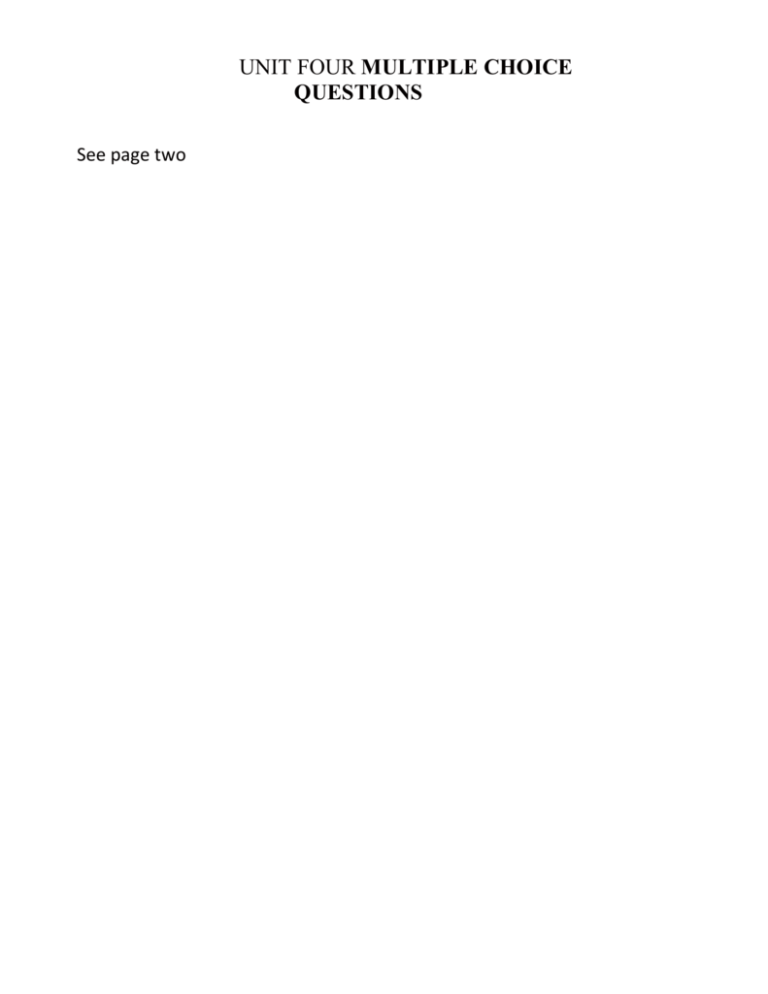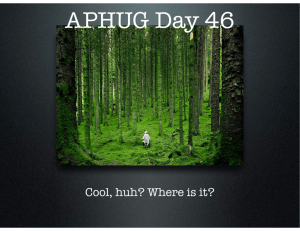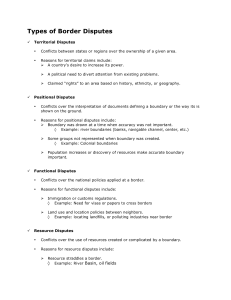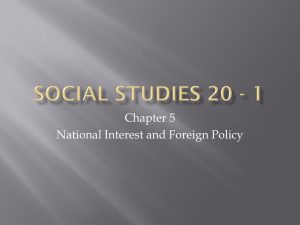UNIT FOUR MULTIPLE CHOICE QUESTIONS See page two
advertisement

UNIT FOUR MULTIPLE CHOICE QUESTIONS See page two Practice Political test questions E. Woods Review 1. An effort to control pieces of the earth’s surface for political and social ends is called: A. Politics B. territoriality C. political culture D. ethno nationalism E. federalism 2. A geographic zone where no state exercises power is called a (n) A. frontier B. boundary C. ethnic zone D. separatist area E. landlocked area 3. The boundary between two countries is set by a river that runs between them. This type of try is known as a: a. cultural boundary b. geometric boundary c. physical boundary d. relative boundary e. perforated boundary 6. Which of the following states has the least desirable relative location? a. Mexico b. Britain c. Egypt d. China e. Kazakhstan 7. All of the following are landlocked states EXCEPT: a. Bhutan b. Peru c. Belarus d. Paraguay e. Armenia 8. The Great Wall of China is an example of a boundary that historically has served the function of a. protection b. nationalism c. elongation d. cultural diffusion e. assimilation 9. If two countries argue about exactly where the border between them is located, it is called a: a. positional dispute b. territorial dispute c. resource dispute d. functional dispute e. operational dispute 4. The state above has a shape that categorizes it as a(n) a. compact state b. prompted state c. elongated state d. fragmented state e. perforated state 5. Cabinda is a part of the African state of Angola that is separated by the Democratic Republic of the Congo. It is an example of a(n) a. elongated state b. perforated state c. enclave d. exclave e. microstate 10. Which point in the diagram above is the core area of the nation-state? a. Point A b. Point B c. Point C d. Point D e. Point E 11. If a state's boundaries do not closely follow the outline of a group bonded by a common political identity, the state is not consistent with a. its sovereignty b. its core area c. devolutionary forces d. its size e. the nation 16. All of the following were colonies that gained their independence from the late 1940s through the 1960s EXCEPT: a. India b. Singapore c. Lithuania d. Nigeria e. Zimbabwe 12. If the point identified in #11 is a capital city that serves as a model for national objectives, it is a(n) a. ethnic capital b. electoral capital c. minority/majority district d. forward capital e. heartland city 17. Which of the following is MOST likely to serve as a centripetal force within a state? a. tendency for the government to keep its power focused in a central geographical location b. strong institutions that challenge the government c. numerous separatist movements d. minority ethnic groups that live along the periphery d. overall strong sense of nationalism 13. The strange shape of the U.S legislative district above most likely resulted from: a. a history of close elections b. preference for Republican candidates c. preference for Democratic candidates d. gerrymandering e. malapportionment 14. During which time period did African land areas have such names as "French West Africa," "British Somaliland," "Belgian Congo," and "German Southwest Africa"? a. early 1600s b. late 1700s c. late 1800s d. mid 20th century e. early 21 51 century 15. Which of the following is the BEST description of the geographic distribution of power within states today? a. Most states are federal systems. b. Most states are confederal systems. c. Most states are unitary systems. d. States with federal systems are about equal in number to states with unitary systems. e. States with confederal systems are about equal in number to states with unitary systems. 18. In recent years Britain has allowed the Welsh and Scottish parliaments to set political policies for their regions. This process is called a. fragmentation b. ethno nationalism c. integration d. devolution e. confederalism 19. Which of the following is the BEST explanation for the break-up of the nation-state of Yugoslavia during the 1990s? a. pressure from the Soviet Union to trade exclusively with them b. ethnic devolutionary forces c. centripetal forces encouraged by the Yugoslav government d. disputes over natural resources e. disputes over membership in the European Union 20. According to Mackinder's heartland theory, which of the following countries would be MOST likely to dominate the globe? a. the United States b. Britain c. China d. India e. Russia 21. Which of the following is an important change in the nature of sovereignty brought about by the United Nations? a. For the first time, an international government exists. b. The sovereignty of individual nation-states has been strengthened. c. It places an emphasis on regional sovereignty, not national sovereignty. d. It has created an international army with almost unlimited authority to fight and defeat the armies of defiant nations. e. It has changed the dynamics of international relationships from the previous almost exclusive focus on the sovereignty of nation-states. 22. The main responsibility of the United Nation’s Security Council is to: a. provide health and other general welfare assistance internationally b. facilitate trade and other economic transactions among nations c. settle international disputes that require judicial decisions d. prevent disputes among nations from erupting into wide scale war e. decide requirements for admitting new members to the organization the United Nations 23. All of the following are regional supraorganizations that have formed since 1945 EXCEPT: a. the United Nations b. NATO c. the Warsaw Pact d. European Union e. Organization of American States 24. The European Union’s roots for cooperation lie primarily in: a. sharing cultural strengths b. settling judicial disputes c. promoting mutual economic goals d. reuniting Western and Eastern Europe e. developing a common foreign policy 25. According to Samuel Huntington, which of the following is a 20th century trend that promotes fragmentation? a. democratization b. politicization of religion c. movement toward market economies d. development of regional supranational organizations e. proliferation of international, large scale wars 5.







